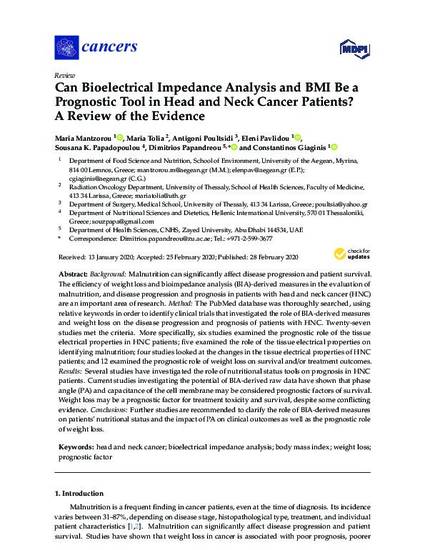
© 2020 by the authors. Licensee MDPI, Basel, Switzerland. Background: Malnutrition can significantly affect disease progression and patient survival. The efficiency of weight loss and bioimpedance analysis (BIA)-derived measures in the evaluation of malnutrition, and disease progression and prognosis in patients with head and neck cancer (HNC) are an important area of research. Method: The PubMed database was thoroughly searched, using relative keywords in order to identify clinical trials that investigated the role of BIA-derived measures and weight loss on the disease progression and prognosis of patients with HNC. Twenty-seven studies met the criteria. More specifically, six studies examined the prognostic role of the tissue electrical properties in HNC patients; five examined the role of the tissue electrical properties on identifying malnutrition; four studies looked at the changes in the tissue electrical properties of HNC patients; and 12 examined the prognostic role of weight loss on survival and/or treatment outcomes. Results: Several studies have investigated the role of nutritional status tools on prognosis in HNC patients. Current studies investigating the potential of BIA-derived raw data have shown that phase angle (PA) and capacitance of the cell membrane may be considered prognostic factors of survival. Weight loss may be a prognostic factor for treatment toxicity and survival, despite some conflicting evidence. Conclusions: Further studies are recommended to clarify the role of BIA-derived measures on patients’ nutritional status and the impact of PA on clinical outcomes as well as the prognostic role of weight loss.
- Bioelectrical impedance analysis,
- Body mass index,
- Head and neck cancer,
- Prognostic factor,
- Weight loss
Available at: http://works.bepress.com/dimitrios-papandreou/25/